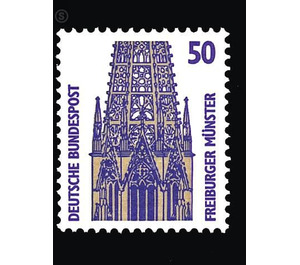Postage stamp: sights - Germany / Federal Republic of Germany 1987 - 50 Pfennig
Theme: Architecture
| Country | Germany / Federal Republic of Germany |
| Issue Date | 1987 |
| Face Value | 50.00 |
| Color | brown white |
| Perforation | K 14 |
| Printing Type | indirect 2-color letterpress |
| Stamp Type | Postage stamp |
| Item Type | Stamp |
| Chronological Issue Number | 1213 |
| Chronological Chapter | GER-BRD |
| SID | 790924 |
| In 65 Wishlists | |
With »Landmarks«, the Deutsche Bundespost replaces the series »Castles and Palaces«, begun in 1976/77. The new permanent series with its unusual representations of significant cultural and technical achievements out, but should also be an incentive to look at the objects once in the original. The roll marks appear at the same time and the same motif as the inscription »Deutsche Bundespost Berlin« Unlike the neighboring mints of Basel and Strasbourg, which were built as episcopal cathedral, the Freiburg Minster was the parish church of the city founded by the Dukes of Zähringen. Around 1200, the site of a demolished predecessor began with the construction of the present Minster in late Romanesque forms. From the Romanesque transept to the west, the three-aisled nave will be built in about fifty years, in ever-evolving Gothic forms. The tower of the Freiburg Minster is founded by the tower, once called "the most beautiful tower of Christendom". Already at the beginning of the 13th century the tower is completed. More than half of its height of 114 meters occupies the roofless open space with the openwork tracery helmet. The boldness of the construction of this helmet made of filigree flagstones and iron ring anchors and the outline in elegant curve deserve the highest admiration. In 1356, the foundation stone was laid for a huge new choir, built around the Romanesque style, which remains for the time being. Baumeister is a member of the Parler family. It was not until 1513 that this choir, built after a centenary of construction, was consecrated. A rich collection of stained-glass windows from the 13th to the 16th century, the high altar of Hans Baldung and the carved altars of important masters demonstrate, despite many losses, the splendor of the furnishings that have been created over the centuries. (Text: Ministry of the Interior Baden-Württemberg, Stuttgart)


